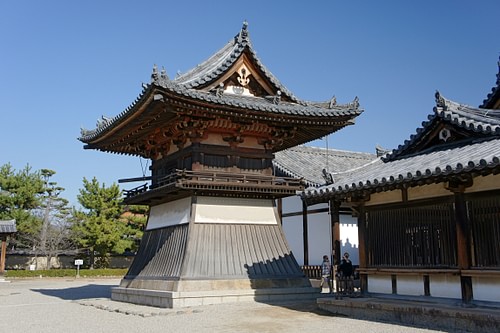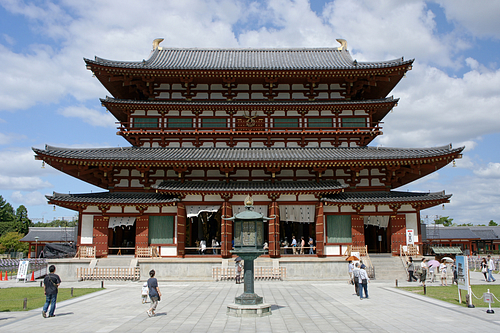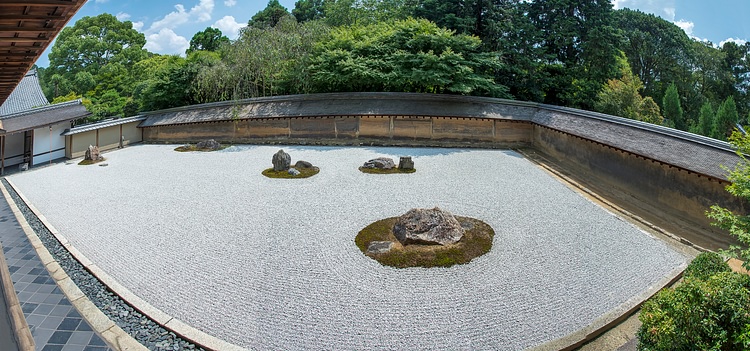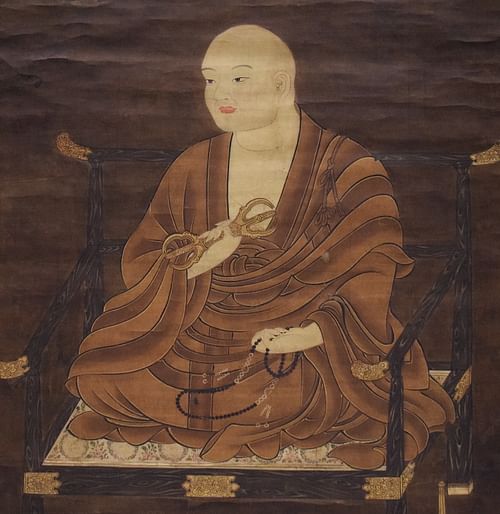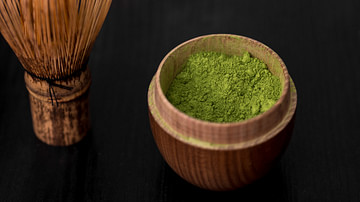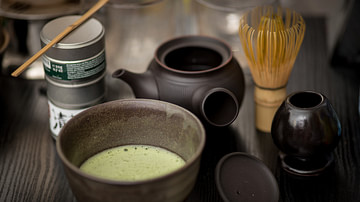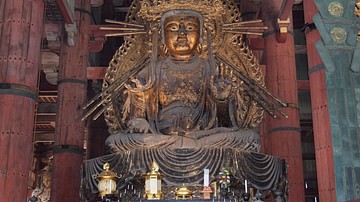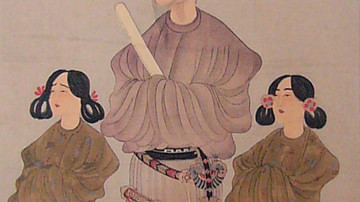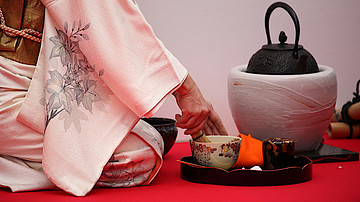Buddhist monasteries have been part of the Japanese cultural landscape ever since the 7th century CE, and they remained both powerful and socially important institutions right through the medieval period. Today, many of Japan's finest examples of ancient and medieval architecture are located at temple complexes, a good number of which are classified as UNESCO World Heritage Sites. The monks who lived, worked, and meditated in Buddhist monasteries not only served their local communities on their way to reaching enlightenment but also produced some of Japan's finest historical works of art in painting, sculpture, and calligraphy.
Buddhism in Japan
Buddhism was first introduced to Japan from mainland Asia in the 6th century CE, and monasteries were built from the 7th century CE, a trend first promoted by the regent Prince Shotoku (l. 574-622 CE). Shotoku would oversee the building of 46 Buddhist monasteries and temples, the most important of which were the Shitennoji (593 CE), Hokoji (596 CE), and Horyuji (607 CE).
Buddhist monasteries were frequently given free land and an exemption from tax by emperors eager to have a blessing on their reign, and this resulted in them becoming both economically powerful and politically influential. Monasteries were even able to pay for their own armed attendants. The monasteries gave back to the local community by performing funeral rituals and providing schools and facilities for higher studies, libraries, and food and shelter to the needy. Monks also helped in communal projects such as road, bridge, and irrigation building, and they offered prayers for both local and national causes.
The next leap forward for monasteries came in the 12th century CE when Zen (Rinzai) Buddhism was introduced from China. This new simplified version of the religion made it more accessible to more people, and there was a consequent growth in those who wanted to pursue the monastic life. There was also an influence of Zen on monastic architecture and especially on their gardens. The boom was brief, though, as the introduction of Pure Land Buddhism, which put much less emphasis on the importance of meditation, meant that the religion could now be easily pursued outside of a monastery. There was, consequently, a decline in monasteries until an intellectual revival of Confucian ideals boosted religion in general in Japan from the 17th century CE.
Buddhism in Japan was largely male-dominated throughout its history with occasional spells when women were regarded more favourably. Certain sacred mountains which had a high concentration of monasteries such as Mount Koya were even off-limits to all women. There was an intellectual bias against them, too, with women considered inferior to men due to the belief that they could not attain the highest spiritual states. The Pure Land sect did treat women equally, and the medieval period did see women join nunneries because of religious conviction. In addition, it was not uncommon for women to join a monastery in order to avoid an arranged marriage or when they became widows.
The Buildings of a Buddhist Monastery
Buddhist temple sites contained (and still do today, of course) a multitude of buildings, each with a specific function and all contained within a particular area. There are buildings for worship, meetings, prayers, training, to house relics and artworks and all living quarters and facilities necessary for the monks' daily needs. Prior to the medieval period, it was considered auspicious to have a particular arrangement and number of buildings within a complex, but this idea gave way to the practical consideration of meeting the needs of the monastic community.
Although each temple is unique, the principal buildings of most Japanese Buddhist temple complexes include:
Gates (Mon) - structures used, along with perimeter walls in some cases, to indicate the boundaries between the sacred temple site and the outside secular world. Other gates erected within the complex may demarcate especially sacred areas which have restricted access, possibly even an entire inner courtyard.
Bell Tower (Shoro) - provides the bell which is used to call monks to prayer and other rituals.
Main Hall (Hondo or Butsudo) - here the most sacred religious images are kept.
Pagoda (To) - the wooden tower structure with a spire built to house sacred relics, especially bodily remains of the Buddha such as a tooth or bone.
Lecture Hall (Kodo or Hatto) - here lectures are given with the lecturer typically standing in front of a range of Buddhist statues along one wall (except for Zen halls which have no sculpture).
Meditation Hall (Zendo) - a place for monks to practise seated meditation.
Sutra Repository (Kyozo) - where important Buddhist scriptures and texts are kept.
Founder's Hall (Kaisando) - a hall venerating the founder of the temple.
Abbot's Quarters (Hojo) - the residence of the abbot which is often connected to the Lecture Hall by a covered walkway.
Subtemples (Tachu) - typically small buildings funded by rich patrons.
Teahouse (Chashitsu or Sukiya) - Some monasteries include a teahouse where the traditional Japanese Tea Ceremony is performed. Tea was first made popular by Chinese Buddhist monks from the 2nd century BCE, and the Japanese added a whole ritual to its serving and drinking, including a special place for it, traditionally a small rustic house of simple materials and bare furnishings. The teahouse may be set in its own special garden (roji), designed to calm the visitor before beginning the ceremony. Imbued with Zen principles, the tea ceremony is often performed for visitors to Buddhist monasteries today.
Shinto Shrines (Jinja) - Buddhism and Shinto have always overlapped to some degree in Japan (until a formal separation in the 19th century CE), and many Buddhist sites have a shrine dedicated to a particular protective Shinto deity or kami.
Gardens - many temple sites have large gardens which are frequently landscaped to represent a vision of the Buddhist paradise. The gardens may have different areas of particular trees such as pines and cherry blossom, or areas of moss and bamboo. There are often water features such as waterfalls and ponds with the latter often containing lotus blossoms - a symbol of enlightenment as the flower springs from muddy depths - and carp fish - a symbol of perseverance as they swim upstream to spawn.
In the case of Zen monasteries, there may be a rock garden (karesansui) containing carefully chosen rocks which are arranged on a bed of immaculately raked gravel or sand, all in order to promote meditation. Rock gardens are not walked in but typically viewed from the wooden verandahs of adjacent buildings.
The Architectural Styles of Buddhist Monasteries
By the Kamakura period (1185-1333 CE) Buddhist temples in Japan were built according to three architectural styles or a combination of them, depending on the particular school of Buddhism the temple was established for. In the early modern period, a fourth style was introduced from China. Thus, the four architectural styles of Buddhist temples in Japan are as follows:
- Japanese Style (Wayo) - this style became prevalent from the Nara period (710-794 CE) and combines Japanese native elements with ideas used in the Tang Dynasty of China (618-907 CE). Japanese elements include leaving wood untreated and unpainted, an emphasis on curved lines and a general simplicity in decoration. Two famous temples built in this style were the original versions of Kofukuji and Todaiji.
- Great Buddha Style (Daibutsuyo) - also known as the Indian Style (Tenjikuyo) in medieval times but actually showing elements of southern Chinese architecture, the most famous examples of this style are the Great Buddha Hall and the Great South Gate at Todaiji.
- Zen Style (Zensbuyo) - also known as the Chinese Style (Karayo) in medieval Japan, the Zen Style came from Song Dynasty China (960-1279 CE) and was popular from the Kamakura period. Notable features include curved fan rafters and bell-shaped windows.
- Obaku Style - introduced from China in the mid-17th century CE, this style has covered walkways between buildings, wall brackets with four tiers, highly decorative railings and the bases of pillars are flamboyantly carved.
The Routine of a Buddhist Monk
The particular routines of monks very much depended (and still depends) on the particular form of Buddhism practised at their monastery. Still, it is true to say that the daily life of a modern monk has not changed all that much from the life practised by their counterparts in the ancient and medieval periods in Japan.
Monasteries are headed by an abbot who is assisted by several senior monks or prelates. Monks must first go through a period of pre-training within a temple before they are officially ordained and permitted to enter a training monastery proper. For a monk to become a temple priest then requires up to three years of training. For a monk to become a trainer of new monks he must complete the temple's full curriculum of studies which may take at least 12 years.
Temples could have hundreds of monks living in them in the medieval period, but nowadays 30 or so is a high number. As one would expect, there were regulations to ensure monks lived the austere life that was considered necessary for their minds to concentrate on reaching enlightenment. Regulations varied depending on the sect and the particular abbot but included such things as wearing coarse robes, prohibiting meat, fish, sake, and spicy food, enforcing celibacy, and encouraging monks not to spit or blow their noses too loudly.
Buddhist monks are perhaps most famous in the outside world for their meditation practices. Meditation may take the form of simply sitting and thinking (zazen in Zen Buddhism) or the contemplation of riddles (koan) such as what is the sound of one hand clapping or what was your face like before you were born? While meditating, the monk may face a wall in some sects or the centre of the room or the room's view in others. A session of meditation is often measured by the time it takes to burn down an incense stick (30-40 minutes).
As an alternative to sedentary meditation, the mind might be focussed by performing simple tasks such as chanting from the sutras, repeating short phrases or mantras, raking the gravel of a dry landscape garden, walking slowly around the grounds or making a mandala - a complex pattern on the floor using coloured sand which visually represents the teachings of Buddha. Zen monks, for example, are expected to meditate for around seven hours a day and, in any case, all the daily tasks they perform should be done with a meditative mind. Even chewing food should cause a Zen monk to contemplate five things: an appreciation of the food, one's worthiness, one's purity, the food's medicinal value, and one's gratitude for the meal.

When not meditating, monks are otherwise occupied in such tasks as studying religious texts, performing necessary labour tasks such as cleaning, gardening, and food cultivation or asking for alms from the outside local community. For temples which are popular tourist attractions, monks may be on hand to help visitors and act as guides. Meals are communal and often taken in silence.
A typical day of a modern Zen Buddhist monk is as follows:
- 4 am Wake up
- 4.10 - 5 am Sutra chanting
- 5- 7 am Zazen and interview with abbot
- 7 am Breakfast of rice gruel, salted plum, and pickles.
- 8 - 10.50 am Cleaning and work duties
- 11 am Lunch, typically barley rice, miso soup, cooked vegetable, and pickled radish
- 1 - 3.50 pm Work duty
- 4 pm Light meal similar to lunch
- 5 - 8.30 pm Zazen and interview with abbot
- 9 pm Lights out
- 9 - 11 pm Night sitting.
(Doughill, 20)
While perhaps not so common today, ancient and medieval monks were often great painters, sculptors and calligraphers, producing works for their own temples and for rulers and the wider community. Kukai (774-835 CE), the founder of Shingon Buddhism, was a scholar, poet and artist who famously made calligraphy an art form in Japan. One of the country's greatest ever painters was the monk Sesshu (real name Toyo, 1420-1506 CE) who specialised in suiboku, that is using only black ink and water on white paper scrolls. It is clear, then, that Buddhist monasteries and their monks have contributed in many ways to everyday life in Japan, both in the past and still today.
This content was made possible with generous support from the Great Britain Sasakawa Foundation.
